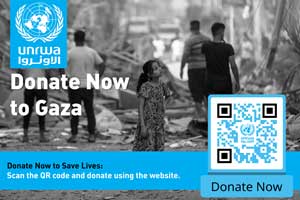You are here
Somalia’s hunger crisis deepens as US Aid cuts threaten lives of millions
By Danielle Robertson - Apr 28,2025 - Last updated at Apr 28,2025

Data from Somalia’s federal government and UN warns that worsening drought, conflict, and soaring food prices could push 4.4 million people into hunger this year (JT File)
AMMAN — Ahmed, just one year old, lets out a piercing scream as doctors measure and weigh his frail body. His mother, Shamsa Warsan, stands next to him, holding him tightly.
“They told me my child is malnourished,” she said. Warsan sits at the front of a long line of mothers, waiting for hours at an overcrowded outdoor clinic in Baidoa, the epicentre of Somalia’s growing hunger crisis — for a narrow chance at life-saving treatment.
“We both could have died on the journey,” she said. “My child was very sick. I brought him to the hospital, he was treated and recovered. Without that care, he would not have made it.”
Many of the medical centres here are run by aid agency Save the Children and rely heavily on US funding to stay open. But recent cuts mean the chance of survival for others like Ahmed and Hassan is quickly fading.
4.4 Million at Risk as Hunger Spreads
New data from Somalia’s federal government and the UN warns that worsening drought, conflict, and soaring food prices could push 4.4 million people — nearly 23 per cent of the population — into hunger this year.
The World Food Programme says children under five will be among the hardest hit, with around 1.7 million expected to suffer acute malnutrition by December 2025.
Aid agencies on the ground say US funding cuts have deepened the crisis, forcing some life-saving clinics to shut their doors.
“Nobody saw this coming. We have had to lay off around 150 people because of funding, we have to close field offices and it has compromised our capacity to deliver,” said Binyam Gebru, deputy country director for Save the Children in Somalia.
According to figures from Stand Up For Aid, a grassroots advocacy group, the US has slashed $170 million in aid to Somalia.
“If we do not have the resources we cannot provide those very low cost but high impact interventions, children will die,” Gebru said.
Vice Minister for Humanitarian and Disaster Management in South West Somalia Abdullahi Isak Ganay issued an even starker warning.
“If the aid is cut during this crisis, we could end up in a situation like we did in 1991,” he said.
That year, famine swept across Somalia, fuelled by civil war, drought, and the collapse of the central government. An estimated 300,000 people died, most of them children, in one of the deadliest humanitarian disasters of the 20th century.
Now, a generation later, Somalia’s youngest once again face the same deadly threat, this time, compounded by Al Shabaab.
Al Shabaab’s Advance Deepens the Crisis
Al Shabaab, Al Qaeda’s East Africa affiliate, has recently gained ground in central Somalia, claiming to have seized a military base and the town of Wargaadhi, a claim the government denied.
Seizing the base would allow Al Shabaab to cut off a key trunk road linking the capital, Mogadishu, 200 kilometres to the southwest, with Galmudug State.
“This is a very dangerous turning point,” Gebru said. “That will impede our capacity to deliver supplies to communities.”
A City of Sorghum, Now a City of Tents
Nowhere is the strain more visible than in Baydhabo, once known as the “City of Sorghum.” Once fertile and full of life, its fields are now covered in tents as families flee drought, failed crops, and Al Shabaab’s violence.
Hodan Abdi Warsame, who now shelters under makeshift sheeting in the sprawling camps of Baydhabo, shared her story: "I used to live in Deygaab village. After my husband passed away, I didn’t receive any help. I had to flee due to hunger, and eventually, I arrived here in Baidoa seeking assistance."
She explained the hardships she faced after her husband's death: "Since then, I was forced off my farm. Al Shabaab got involved in the matter, but nothing was ever resolved. Now, I am here alone, while my children are still back in the village."
“Al Shabaab told me they want someone who would take care of the children. They said they wouldn’t hand over the children to a woman who, in their words, had 'misbehaved' by fleeing to Baidoa,” she said.
Compounding crisis push Somalia to the edge
As Somalia faces the compounding crises of conflict, drought, soaring food prices, and US aid cuts, doctors are now giving all they have, and often, working for nothing at all.
“We have learned to serve the community, and if we don’t step up during difficult times like this, our education means nothing,” said Said Abdi Hassan Abdi, a senior medical staff member with Save the Children.
The crisis has forced aid agencies to rethink how they operate, reaching out to non-traditional donors in a bid to fill the growing gap.
“We are reaching out to Middle Eastern donors, to China, because there is a lesson to be learned,” Binyam Gebru said.
“We have been dependent on a single source for too long, and now we are looking at diversifying where our support comes from.
At the end of all this, we will have to reassess the entire landscape, and I believe it will change the industry forever.”
















